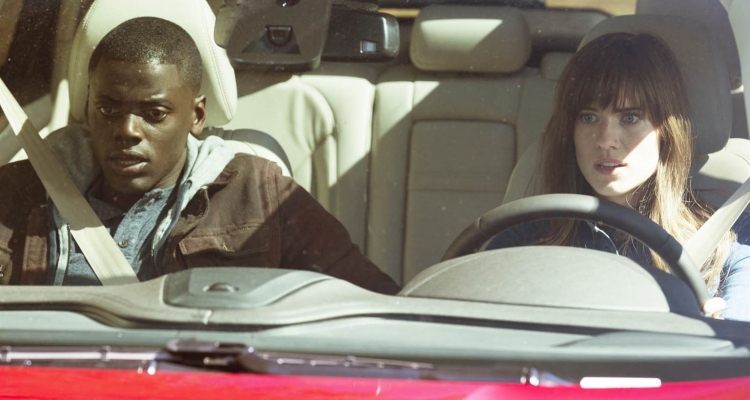8. “The Disaster Artist” (James Franco)
In 2003, “The Room,” a film financed by self-proclaimed impresario Tommy Wiseau for $6 million, was supposed to be the culmination of his imagined talents, his ultimate artistic statement, and the capstone to his suspiciously vague career. But what turned out instead was what many consider one of the very worst movies of all time. The fact that James Franco (director, actor) and company — which includes Seth Rogen, Zac Efron and Kristen Bell as collaborators in the hapless menagerie — have decided to put on a straight face and take it all very seriously, brings a hilariously endearing vibe to the festivities. Wiseau was an L.A. oddball whose age, source of income, and nationality were blatantly fishy. He claimed his entire family hailed from New Orleans, but his distinct Eastern European accent belied that tale. Unlike most directors, his only prior claim to fame in the public eye had been as a street vendor in San Francisco. One way or another Wiseau somehow amassed a fortune as a real-estate entrepreneur and invested $6 million in his folly “The Room.” Though universally ridiculed, it enjoyed an unexpected resurrection as a cult classic in its own right, with recurrent, raucous screenings worldwide. “The Disaster Artist,” therefore, arrives as a double-dip of cinematic devotion separated by 15 years and a million gasps. It’s a valentine to movies that went wrong in all the right ways, an ode to the stinkers which we love and can’t live without.
 7. “Phantom Thread” (Paul Thomas Anderson)
7. “Phantom Thread” (Paul Thomas Anderson)
Paul Thomas Anderson said he was inspired by fashion designer Cristóbal Balenciaga in creating the character of Reynolds Woodcock – a controlling, obsessive stylist, aided by his sister assistant (an excellent Lesley Manville) and who doesn’t have time for love in his life. “Phantom Thread,” Anderson’s 8th movie as writer-director, has Woodcock, played by Daniel Day-Lewis, falling for strong-willed Alma (Vicky Krieps), who soon becomes a turbulent fixture in his life as his muse and lover. The opening sequences are entrancing. With barely any dialogue, and Jonny Greenwood‘s score weaving a beautiful, lush symphony of pianos and violins, PTA draws you into his world of models and dressmakers at the House of Woodcock. The entry of a perfect muse in the form of Vicky Krieps’ Alma brings about an unequal affair between the dressmaker and the young lady. Their strong will, intense romance, breathless moments of pure expression all set in the fashion era of 1950 is very much breathtakingly served by Anderson, who seems really keen in showing us a love story that is more than just about lust, but about the most primal and internal motherly affection most men still crave in their adulthood. The chemistry between the unlikely duo flies off the screen in the forms of upturned lips, gentle touches, and warm laughter. The viewer is always on the outside looking in, we never see them having sex, nor do we truly witness important personal moments between the two, that creates an unusual pacing that will surely put off unadventurous moviegoers. Although it might be deemed his most classically structured film, “Phantom Thread” is a true original. It is less esoteric than the director’s last couple of films, and he even serves as his own DP here. The breathtaking cinematography, shot on a 35mm camera, is a clear highlight. There’s a dazzling array of tracking shots and intense close-ups that make this truly feel like a PTA movie. It might also be his most experimental picture, even more so than “Punch-Drunk Love,” in that the narrative is replaced for ambiance and character studies of the highest cinematic order.
6. “Nocturama” (Bertrand Bonello, France)
Hyper-realized, Bertrand Bonnello‘s “Nocturama” can sometimes make the viewer uneasy, especially in its finale, which refuses to condemn the actions of the film’s terrorists. The visually masterful film, think Jacques Rivette, seems to take sides with the Marxist terrorists at the forefront of the story, even though Bonnello has been quite outspoken about his film NOT being political. “Nocturama” seems to be saying that these are not really terrorists, but “troubled youth” that have been hampered down by a flawed social and economical system. Owing to Robert Bresson’s “The Devil, Probably” and George A. Romero’s “Dawn of the Dead.” “Nocturama” presents no easy answers; what it does offer is one of the 21st century’s most stirring cinematic experiences. Yes, the ending is ideologically dubious, which is what has irritated French critics the most. Bonnello has talent, his views are complex and the film also raises interesting questions. He should be taken seriously and I’m looking forward to the response from American critics.
 5. “The Big Sick” (Michael Showalter)
5. “The Big Sick” (Michael Showalter)
All hesitations you might have had about this Judd Apatow-produced film were thrown out the window once Kumail Nanjiani appeared in Michael Showalter’s millennial romantic comedy “The Big Sick.” Najiani, known for his supporting role in HBO’s “Silicon Valley,” doesn’t need to act as much as just be himself on-screen. The film is a touching and heartfelt personal account of his real-life relationship with his wife Emily Gordon (as played beautifully by Zoe Kazan), which was initially troubled by an undisclosed illness which left her hospitalized in a coma. “The Big Sick” is one of the best romantic comedies to come around in ages, a future classic of the genre. Sometimes the movie Gods align and everything in a production ends up working; the actors, the screenplay, the director, the photography. An effortlessly great film is born in the process. This is the best Judd Apatow movie and it wasn’t even directed by Apatow.

